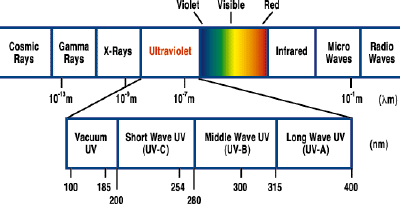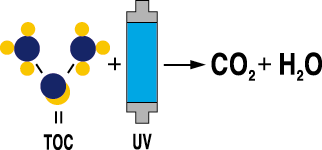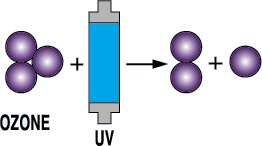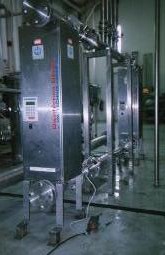UV disinfection Systems |
A greater public awareness of contamination in water supplies has occurred in recent years which has resulted in the successful application of alternative methods of treatment, like UV treatment.
 Light
is electromagnetic radiation, or radiant energy traveling in the form of
waves. UV energy is found in the electromagnetic spectrum between visible
light and x-rays and can best be described as invisible radiation. The
energy employed for UV water treatment is further categorized into two
primary levels measured as wavelengths - 254 nm and 185 nm, where nm =
1/1000 of a micron. For disinfection and ozone destruction applications,
the 254nm wavelength is utilized. For TOC reduction and chlorine destruction
applications a unique wavelength.
Light
is electromagnetic radiation, or radiant energy traveling in the form of
waves. UV energy is found in the electromagnetic spectrum between visible
light and x-rays and can best be described as invisible radiation. The
energy employed for UV water treatment is further categorized into two
primary levels measured as wavelengths - 254 nm and 185 nm, where nm =
1/1000 of a micron. For disinfection and ozone destruction applications,
the 254nm wavelength is utilized. For TOC reduction and chlorine destruction
applications a unique wavelength.

Hrushikesh UV systems feature low
pressure mercury discharge lamps. The lamps are constructed with a special
quartz envelope material that looks like glass, but is actually a discriminating
filter. This allows predominantly 254 nm or 185 nm UV energy to be transmitted
into a water stream as it flows through the UV system's treatment chamber.
The primary uses of UV for water treatment are: Disinfection, TOC Reduction, Ozone Destruction and Chlorine Destruction.
 Disinfection:
All living organisms contain DNA (deoxyribonucleic acid). DNA provides
the mechanism for all functions needed to sustain life.
Disinfection:
All living organisms contain DNA (deoxyribonucleic acid). DNA provides
the mechanism for all functions needed to sustain life.
Hrushikesh UV systems emit UV light that penetrates the outer cell membrane of microorganisms, passes through the cell body, reaches the DNA and alters the genetic material. The microorganism is thereby destroyed in a non-chemical manner and is unable to reproduce.
 TOC
Reduction: In ultrapure water systems,
UV systems are used for the effective reduction of organics, commonly referred
to as TOC (total oxidizable carbon).
TOC
Reduction: In ultrapure water systems,
UV systems are used for the effective reduction of organics, commonly referred
to as TOC (total oxidizable carbon).
The 185 nm wavelength of UV light
is used for TOC reduction, which is shorter and consequently more powerful
than the 254 nm wavelength. UV energy promotes hydroxial free radicals
in varying degrees of photochemical excitement. These hydroxyl (OH-) free
radicals break various chemical bonds of organics, which in turn produce
chain reactions, oxidizing most organics into CO2 and H2O - the basic building
blocks of all organic compounds. Both TOC reduction and microbial destruction
occur with the use of Aquafine 185 nm UV systems. Hrushikesh TOC Reduction
Units are capable of achieving <1 ppb TOC Specification.
 Ozone
Destruction: In some water treatment applications,
ozone is applied to the water to oxidize trace organics, or to disinfect
the piping and distribution system, but residual ozone is often left behind.
Hrushikesh ozone destruction units add UV energy to ozone, catalyzing the
ozone into harmless oxygen. Hrushikesh ozone destruction units have Ozone
destruction capability to 20 ppb.
Ozone
Destruction: In some water treatment applications,
ozone is applied to the water to oxidize trace organics, or to disinfect
the piping and distribution system, but residual ozone is often left behind.
Hrushikesh ozone destruction units add UV energy to ozone, catalyzing the
ozone into harmless oxygen. Hrushikesh ozone destruction units have Ozone
destruction capability to 20 ppb.
Chlorine Destruction: UV
radiation can effectively eliminate residual chlorine/chloramine present
in water. Research studies in this area were triggered by the recognition
of the undesirable, negative effects of conventional dechlorination technologies
such as activated carbon filtration and sodium metabisulfite injection.
Both of these processes have significant inherent drawbacks. Carbon beds
are excellent breeding grounds for bacteria to thrive and proliferate.
Chemical addition involves the introduction of an added substance and is
therefore undesirable.
As an alternative to use of chemicals
and activated carbon beds, UV technology can be utilized to destroy chlorine/chloramine,
thereby eliminating the need for chemical handling, bacteria problems,
etc. Research studies have demonstrated conclusively the Free Chlorine
residuals up to 1.0 ppm and Chloramine residuals up to 2.0 ppm can be successfully
destroyed by the application of UV radiation.
Advantages of UV Systems
- UV does not alter taste, odour, colour or pH of the water
- UV does not require the addition and handling of chemicals
- UV does not impart toxic by-products into the water like chlorine
- UV systems are compact and easy to install
- UV systems require very little maintenance
- Running costs are lower
With experience in industries, Hrushikesh
Water Sciences has an overall understanding of the design and construction
of water systems for these applications, as well as in unique applications.
Following models are available:
 Lo-Flow Economy (HLFE) - 0.2 to
9.1 m3/hr
Lo-Flow Economy (HLFE) - 0.2 to
9.1 m3/hr
These units provide a compact design and economical ultraviolet water treatment for low-flow applications, such as laboratory and medical facility water, pharmaceutical make-up processes, final electronic component rinsing and recirculation loops, to name a few. The little change in water temperature, even after prolonged periods of no water flow, makes them ideal for such applications as water for vending machines. These models may also be configured for TOC reduction or ozone destruction applications found in high purity or ultra pure water processes. These are available with flow rates ranging from 0.2 to 9.1 m3/hr.
. In-Door (HID) - 9 to 118 m3/hr

The In-Door Series features a compact design that incorporates a UV treatment chamber with an electrical cabinet that contains all electrical components and instrumentation. These compact, UV models are engineered for indoor installations and controlled operating environments. The In-Door series is used in laboratory, hospital, and hotel installations, as well as cosmetic, pharmaceutical and semiconductor manufacturing processes. UV disinfection flow rates for the standard In-Door models range from 9 to 118 m3/hr, with TOC reduction and ozone destruction configurations also available.
. Out-Door (HOD)- 2 to 118 m3/hr
These Models feature a UV treatment chamber connected by a flexible, liquid-tight conduit to a separate electrical control panel. The cabinet is rated IP 67, making it suitable for many harsh indoor and outdoor environmental conditions. UV disinfection flow rates for these models range from 2 to 118 m3/hr, with TOC reduction and ozone destruction configurations also available.

Sanitary Design Model (HSD)- 2
to 118 m3/hr
UV models are for highly critical industrial water treatment systems. Developed for use in biopharmaceutical applications, this series is perfect for any pure water application with stringent quality or performance criteria. With different models ranging from 2 to 118 m3/hr can serve most any medium flow rate process. This also comes standard with completely sanitary inlet/outlet connections (flanges are optional) and an ingenious sanitary ferrule endplate design that replaces more common bolted and threaded designs. A straight drain and optional stainless steel compression nuts for hot water sanitization or steam sterilization round out the product offering.
FEATURES AND OPTIONS
. Capacities listed are for disinfection
only. For other applications, contact us.
. Capacities are based after 9,000
hours of operation with a coefficient of absorption of 0.06 at 254nm.
. UV Dosage: > 30,000-Microwatt
Seconds/cm2
. Optional Ra 15 (240 grit) Internal
Finish
. Standard Operating Pressure (6
bar)
. Optional Running Time Indicator
. 316-L Stainless Steel Treatment
Chamber
. Optional 4-20 mA Output Signal
. 304 Stainless Steel Cabinet Housing
. Optional Temperature Safety Control
. 240 VAC, 50 Hz Electrical Circuit
. Optional Lamp Out Alert Circuit
. Optional Voltage Stabilizer
. Optional UV Intensity Display
Specifications are subject to change without notice. Optional features shown are available at an additional charge.
We don't just sell products, we provide solutions!
For all your water related problems contact us! We will provide you technically best suitable but most economical solution!






